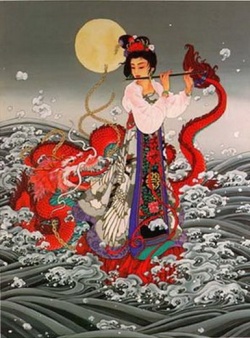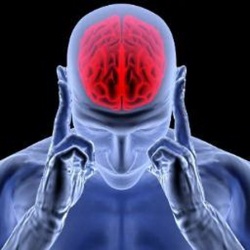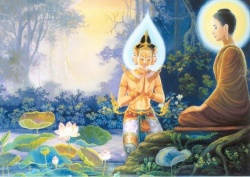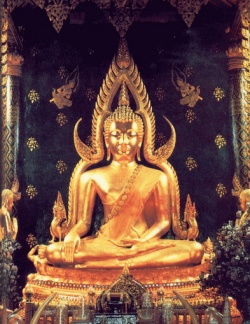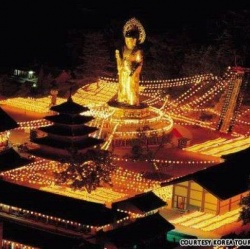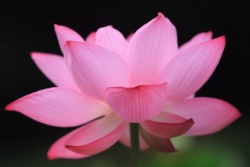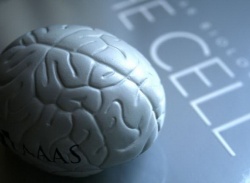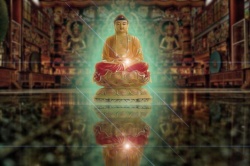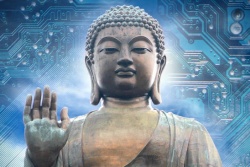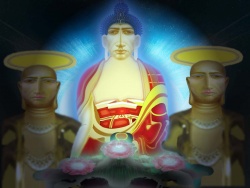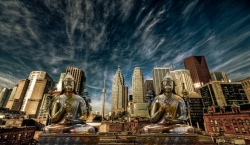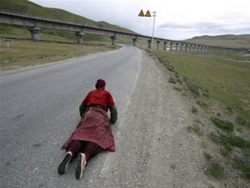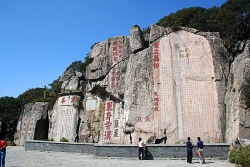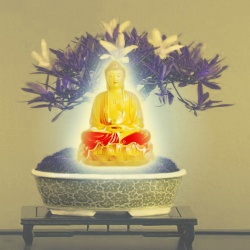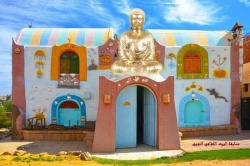The commentary on the Formless Gatha
Introduction
by Master Yung Hsi, and edited by Dr Chou Hsiang-Kuang
The Fa Bao Tan Jing(1) was delivered by Huineng [638-713], the Sixth Patriarch of the School of Chan (Dhyana) Buddhism of China.
It discusses the realisation of the Essence of Mind.
It is not based on superstition, nor does it fall into the same line of thought as the teaching sects of Buddhism.
It is indeed a wonderful book in the ocean of Buddhism. It has been translated into English, German, and other foreign languages.
It can be said that [through it] Buddhism has been propagated in the western countries.
The Fa Bao Tan Jing is divided into ten chapters. Of these the chapter on Prajñya (Wisdom) is important, and in the Prajñya Chapter the Formless Gatha is most important.
In studying this book we must read every sentence carefully.
Only after doing so shall we be able to understand the aims and objectives of Chan Buddhism.
After that, when we speak of Chan Buddhism, it will not be mere empty talk, and others will not cheat us on this very subject, nor will we cheat ourselves.
The Formless Gatha contains sixty sentences of five words each.
The meaning of these sentences seems very easy.
If educated people read them carefully, there will be no need for comments and explanations.
In fact there is a supreme meaning inside the gathas(2) that explains the whole idea of the Fa Bao Tan Jing and the secret Dharmagate of the Tung Shan School(3) that Huineng preached.
Notes:
(1) The Platform Sutra. (2) A gatha is a song or a verse. (3) The Tung Shan School is the School of the 4th and 5th Patriarchs who lived in Tung Shan (Eastern Hill).
This commentary is published on the Net because it is such an utterly Chinese expression of Buddhism, and could therefore serve as a comparison with other such texts.
The original wording in the following pages follows the old Wade-Giles spelling method.
The footnotes between [ ] are additions by the webmaster.
Since the translator had some difficulty in faithfully rendering the two extensive passages from the Lotus Sutra in the discussion of Gatha 3, it has been decided to give the translation by the late prof H. Kern, which seems to be the most comprehensive and objective version.
The Three Traditions are the Traditions of Confucianism, Taoism and Buddhism.
Right after the introduction of Buddhism in China the exegetes had to rely on the Confucianist and Taoist discourse in order to get the Buddha-Dharma accross; this indigenisation even went as far as hoisting Buddhism on the wagons of Confucianism and Taoism.
There are innumerable accounts of this, and these accounts, dating from the early ages of Buddhism in China, have led to the assumption that 20th (and 21rst) century Chinese Buddhism still is heavily influence by the other two Tradition.
Especially since a complete translation of the Avatámsaka Sūtra became available this assumption has to be corrected.
What initially appeared as Taoist discourse in Buddhist exegesis can now be attributed to the said Sūtra.
We may now come to the conclusion that the main tenets of the two other Traditions are used to illustrate the Buddha-Dharma, rather than being used as an illustration of how much Buddhism 'really' is a form of Taoism and/or Confucianism.
This, however, excludes Master Yung Hsi's words on the true gentleman, the chün-tze or jūnzi; this Confucianist concept truly has become a trait of Chinese Buddhism, and lies behind the worldview of the ancient Japanese samurai - to give an example.
The venerable also extensively made Hsi Yün's (a.k.a. Huangbo) words his own.
Huangbo was the third or fourth successor of master Huineng.
As of gatha 5 the commentary speaks several times of Tao.
In the Taoist sense of the word it means "the way things take, the course of things." In general philosophical terms it stands for any set religious or philosophical doctrine.
In Buddhism it is an imperfect translation of the Sanskrit word marga, Path.
And as the Path is at the same time both the means and the end, tao also means 'method'; see also gatha 9 for an explanation on the word bodhi, tao or chiao.
Tao also means piety.
It is customary, especially among the Zen Schools that sprung up in the West, to keep a certain doctrinal purity.
The inheritors of the Japanese Rinzai Tradition (Chin. Lin-chi) will teach the famed Rinzai Master's Dharma, The Soto Tradition does likewise.
There is little or no 'cross fertilization', both in order to keep the teaching lineage pure, and to prevent the student-meditator from feeling incertain about particular views.
Chinese Buddhism as a whole, and Chinese Chan in particular, never bothered much about this type of purity.
Its aim is more to stress the common traits in this and that Dharma exegesis.
We therefore see how Master Yung Hsi used the teaching of a southern Ho-tse Chan Master like Tsungmi to demonstrate the correctness of the northern Tungshan lineage.
Such cross cultural behaviour occurs very often and is perhaps characteristic for Chinese Buddhism.
In case some citations not previously posted on The Web or published in books are not rendered as they should be, it would be very good if you would be so kind as to send in corrections. See the email address below.
Gatha 1
Commented by Master Yung Hsi, translated by Dr Chou Hsiang-Kuang
(Original) Shui T'ung Chi Hsin T'ung | Ju Jih Ch'u Hsu K'ung
(English version) A master of the Buddhist canon as well as the teaching of the Chan School | May be likened unto the blazing sun sitting high in his meridian tower.
The word shui means speech, or it expresses the idea as it is spoken.
The word t'ung means to communicate or to understand thoroughly.
The word chi means and or with.
The word hsin means empty, formless, the mind of non-action, or the mind of suchness.
The word ju means seems to be.
The word ch'u means located at.
The words hsu k'ung mean void (empty).
This means that if the mind is clear and bright, it can shine everywhere.
If we then speak of worldly affairs, they will be easily understood, or if we speak of reasons, they too are easily understood.
It is like the blazing sun shining in every corner of the world.
By such explanation of the sentences of the gatha, the meaning will be clear.
If the followers of the Chan School of Buddhism read the above explanation, the meaning does not appear to be exact, and [in a reading without commentary it] will confuse the real idea of what the Sixth Patriarch wished to preach.
Our ancient sage said, "If we try to explain the meaning according to the words of each sentence, the Buddhas of the Three Periods (past, present and future) will feel grieved."
I am an educated person.
For the last thirty years I have studied the commentaries on the various sūtras and shastras(1), and also conducted research. Therefore I myself can well understand the meaning of the words.
One day I thought that my opinions and explanations on certain points were very correct, and I showed them to my Master Hsü Yün.
He refuted them.
I went back to my house greatly depressed and could not sleep the whole night.
Next morning my whole body was filled with perspiration.
At that moment the gate of Chan Buddhism opened; I became aware that if we explain the sages' words only from books, it will be like scratching your itch at the exterior of your shoe.(2)
Now, the explanation of these two gathas: A master of the Buddhist canon as well as the teaching of the Chan School | May be likened unto the blazing sun sitting high in his meridian tower.
Is this [rendering] correct? Actually, when the Chan School explains the word t'ung it must be in accord with Buddha's original ideas, as well as be consistent with the very opportunity of a person.
The meaning of 'very opportunity' points into the direction of a person whose capacity and degrees of learning for receiving the Dharma [have ripened], and where the knots of doubt in his bowels are.
Otherwise, even if you talk of things beautiful like flowers, they [your words] are of no use.
It would be like the Dhyana Teacher Chia Shan who came to the world to preach the Buddha Dharma.
One day a monk came to Chia Shan and asked:
- 'What is the idea of Dharmakaya?'(3) - 'Dharmakaya is formless,' said Chia Shan. - 'What is the idea of Dharma-eye?' - 'Dharma-eye is defectless,' answered Chia Shan.
Such explanations, according to the words, are not wrong.
At that time Dhyana teacher Tao Wu was present, and laughed at Chia Shan whose anwers were not in accordance with the very opportunity in that person [i.e., the monk asking his question].
Dhyana teacher Chia Shan stepped outside the Preaching Hall and asked Tao Wu:
- 'What I said to the monk was incorrect, and therefore you started laughing. I hope you will be good enough to give me a pointer.'
- 'It seems that you came to this world without your teacher,' said Tao Wu.
- 'Please point out where I made a mistake.'
- 'Your solution lies with the boatman of Hwa Ting.'
- 'What is this boatman [like]?'
- 'This boatman has not even a piece of [roof]tile above [his head] and no borer(4) to stand.'
Dyana teacher Chia Shan dressed himself and went to see the boatman.
When they talked, the boatman beat Chia Shan overboard.
When Chia Shan had climbed into the boat again, the boatman said: 'Now you speak, now you speak!' Chia Shan started speaking and was immediately beaten overboard again; he became enlightened(5).
The boatman said, 'I have been fishing everywhere.
This time I netted a golden fish.'
Thereupon Chia Shan went back home and Dhyana teacher Tao Wu sent him another monk who asked:
- 'What is the idea of Dharmakaya?' - 'Dharmakaya is formless.' - 'What is the idea of Dharma-eye?' - 'Dharma-eye is defectless,' said Chia Shan again.
This monk went back to Dhyana teacher Tao Wu and told him. 'This time the fellow is enlightened,' said Tao Wu.
Judging from this kung-an(6) we understand that Chia Shan's answer to the former monk, that made Tao Wu laugh, [was inopportune(7)]; but his answer to the latter monk, Tao Wu approved.
Hence, the Chan Buddhist teacher's words must be in accordance with the very opportunity of the person in question, otherwise he cannot be said to be a 'master of the Buddhist canon.'
If we want to find the very opportunity in a person, we must know where that opportunity lies.
If we wish to be a master in this, we must understand Chan Buddhism thourougly, and if we wish to understand Chan Buddhism thouroughly, we must make our mind like the blazing sun in the sky, without any support.
Because the sun is without any support, it sheds its light everywhere. Were the sun supported by whatsoever, then it could not shed its light everywhere.
For example, a lamp is supported by a stand; it cannot light the stand.
That is why the Dhyana teacher Tao Wu asked Chia Shan to see the boatman.
Chia Shan inquired, 'what is the boatman?' 'This boatman has not even a piece of tile above and no borer to stand,' answered Tao Wu.
Wouldn't you say that this alone shows that the boatman's vision was like the blazing sun in the sky, without any support?
If we try to explain the meaning of those sentences, A master of the Buddhist canon as well as the teaching of the Chan School | May be likened unto the blazing sun sitting high in his meridian tower, according to the words, without emphasizing the Buddha's original ideas and the very opportunity of a person, wouldn't you think that this would be a grievance to the Buddhas of the three periods?
We should know that the Chan School is also called the Hrdaya (heart) School.
The hrdaya is the nature, and the speech means utility.
Hrdaya means origin, and the speech is the end.
The origin can cover the end.
Therefore, if your heart is enlightened, you can master the Buddhist canon.
But understanding the Buddhist canon does not make you enlightened.
Dhyana teacher Ching Po To asked priest(8) Tao Sheng:
- 'Which sūtra are you preaching?'
- 'The Mahaparinirvana sūtra.'
- 'What is the meaning of nirvana?'
- 'ni' means not-birth, and 'van' means not subject to annihilation. Therefore 'neither birth nor annihilation' means nirvana.
- 'Is this Buddha's nirvana? Is that Dharma-master's nirvana?'
- "Are there two meanings of nirvana?' This is my idea about nirvana; what is yours?'
Thereupon Dhyana teacher Ch'ing Po To lifted his ju yi(9) and said to Tao Sheng:
- 'Do you see it?'
- 'Yes.'
- What have you seen?'
- I saw the ju yi in your hand.'
Ch'ing Po To threw his ju yi on the floor and asked again,
- 'What did you see now?'
- 'I saw your ju yi falling from your hand.'
- 'Your views and opinions are just like those of a common man; how [could it be that] your name became so popular,' said Ch'ing Po To angrily. He dressed himself in his robe(10) and went away.
Tao Sheng's disciples started doubting [about their master), and following Ch'ing Po To they asked, 'Our teacher explains us the meaning of [the words] material and immaterial.
To you it seems to be incorrect; may we ask what your idea in this is?'
- 'You should not say that your teacher's explanations are incorrect.
His explanations of 'material' and 'immaterial' are based on the effect, not on the cause.'
- What is the meaning of 'material' and 'immaterial' in the cause?'
- 'If one atom is empty, all atoms are empty; when all atoms are empty, this one atom is empty.
Within the space of one atom there are no other atoms, and in the space of all atoms there is not one [single] atom [[[standing]] alone]', answered Dhyana teacher Ch'ing Po To.(11)
After reading this kung-an, we must decide that, although the priest Tao Shen was a master of the Buddhist canon, his mind was not enlightened.
Therefore he could not understand the real maning of Dhyana teacher Ch'ing Po To's lifting his ju yi.
Another Dhyana teacher by name of Shih Tou (master Stone), had an enlightened mind.
One day upásaka(12) Teng Yin-fung took leave of Dhyana teacher Ma Tsu.
Ma Tsu asked him: - 'Where do you want to go?' - 'I wish to meet the monk Shih Tou.' - 'Shih Tou's road is slippery [the stoney road is slippery].' - 'I have a bamboo cane and a wooden stick with me. I can go everywhere and play for people [as a jugler]; therefore I shall go.'
When Teng Yin-fung had reached Shih Tou's vihāra, he circumambulated the Dhyana couch, raised his stick, and asked: - 'What is the significance of this?'
- 'Good heavens',(13), said Shih Tou.
Teng Yin-fung remained silent and went back.
He recounted the story to Ma Tsu.
- 'Go back, said Ma Tsu, and when he's on the point of answering, exhale twice.'
Teng Yin-fung went back and asked the same question.
Shih Tou exhaled twice and Teng remained silent.
Again Teng went back to Ma Tsu and told his story. Ma Tsu said, 'Didn't I tell you that Shih Tou's road is slippery?'
This is to tell us that the Chan School is the Dharmaparyaya(14) of hrdaya.
It means that when your mind is enlightened, you have mastered the Buddhist canon; by merely understanding the Buddhist canon your mind does not become enlightened.
Notes: (1) [[[Shastra]]: Canonized commentaries.]
(2) Raising the "great doubt", one of the main teaching skills of the Chinese ch'an-master or the Japanese zen-teacher is not originally Buddhist. "...
Engaging in controversy only to diffuse it or abruptly sending away the petitioner so that he might look into himself — these are examples of not counting on speech to operate as instruction and in this way disappointing the listener's expectations so as to favor his awakening."
("Detour and Access", François Jullien, New York 2000, p.270) Mencius (372 - 289 bC), the great son of Confucius used and perfected this skilfull means before the Buddhists did.
(3) [The Song of Enlightenment of Chan master Chuen of Yung Chia, the Dharma successor of master Huineng, and at the same time the 7th patriarch of T'ien Tai, says "The empty illusory is the Dharmakaya".]
(4) [A tool used for drilling.]
(5) [The Japanse word is kenshō)
(6) Kung-an, literally 'public case', i.e. based upon unchanging law.
A convenient translation is 'case' in the legal sense, a 'case' that has been decided and is thereafter used as a precedent.
(7) Inopportune is a concept that occur both in the Annalects of Confucius as in Buddhism.
Confucius used it to indicate that words and action should match.
Buddhism says that intention and words, i.e. actions, should match. In this Buddhist line of thought the intention is most important, it's the fountain head.
Confucius summed his point of view up as "When a man may be spoken with, not to speak to him is to err in reference to the man.
When a man may not be spoken with, to speak to him is to err in reference to our words.
The wise err neither in regard to their man nor to their words." (Annalect 15.5-15.7)
(8) [ Priest. shang after the Sanskrit sangha or sanghin.]
(9) A ceremonial emblem made of jade.
(10) [In the olden days monks never stepped out into the world without wearing their three over-robes.]
(11) [What master Yung Hsi wishes to convey is the meaning of Káshyapa's lifting of the flower. See www.shinzen.org/shinsub3/Bringing the Monastery Home.PDF .
It also shows the influence of the Avatámsaka sūtra that extensively deals with interpenetration of phenomena, using the metaphor of the atom.]
(12) [See for Shitou http://home.pon.net/wildrose/promise.htm, "Shitou's an agreement for participating together", also known als "Investigation into matching halves".
Upásaka. Dedicated lay-follower and supporter.
(13) A rendering by Buddhist Door.
Source
http://www.buddha-dharma.eu/Formless-Gatha-part-2.html
(14) Dharmaparyaya: Dharma-explanation.
